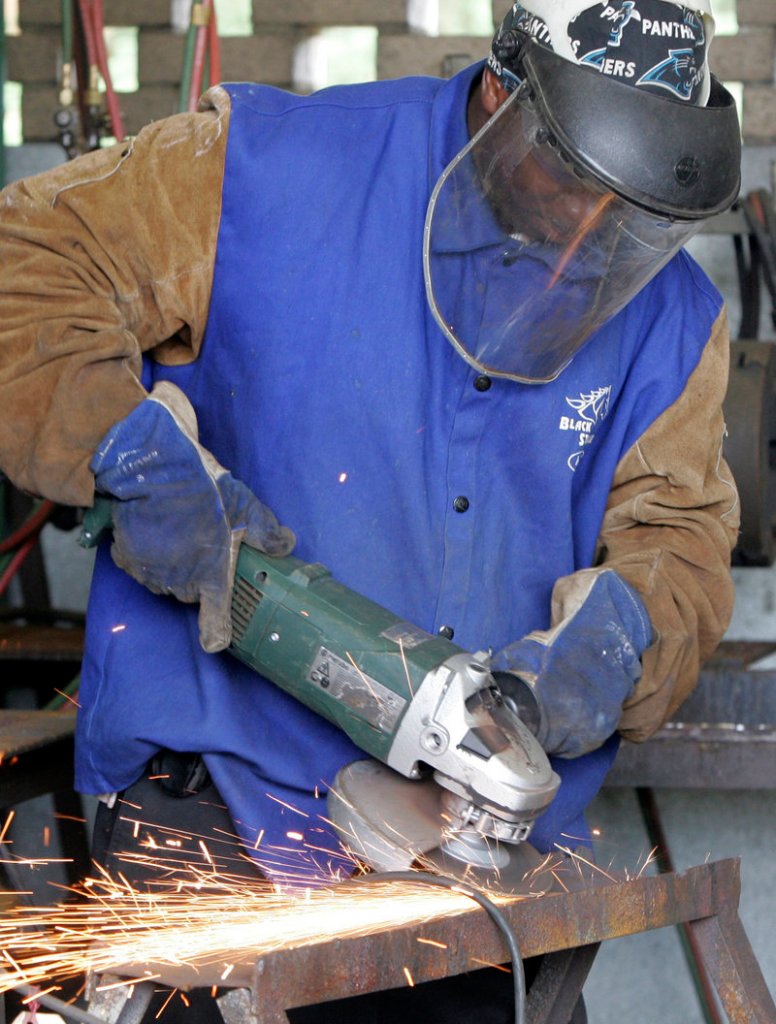PHILADELPHIA — Harold’s fork truck is rated for 4,000 pounds. He has to move and stack 10 skids (pallets) of paper, each weighing 1,500 pounds. What is the maximum number of skids he can lift at one time?
If someone wants a job at Case Paper Co., that person had better know how to calculate the answer. Even more basic: Can the person use a tape measure?
“You’d be amazed at how many people can’t read a ruler to one-sixteenth of an inch,” said Lee Cohn of Case Paper. Case converts huge paper rolls into cardboard boxes, pharmaceutical packaging, even lottery tickets.
Gather a bunch of manufacturers like Cohn in a room, and it won’t take them long to start complaining about their inability to find workers adequately skilled in “shop math,” which can include trigonometry and calculus among other types of mathematics.
For years, shop-math skills weren’t really an issue because manufacturing, as a sector of the economy, was a perennial job-shedder. But since early 2010, manufacturers have been hiring – not enough to replace the nearly eight million jobs lost since the late 1970s, but enough to get policymakers worried about workforce capability.
“We want to get people back to work, and there’s a supply of bodies,” said Anthony Girifalco, a vice president of Delaware Valley Industrial Resource Center, a quasi-public group that assists manufacturers. “There’s demand in the manufacturing sector. But how do you close the skills gap?”
Decades of job loss mean that the surviving workers, who are also the most skilled, are nearing retirement age. The pipeline to replace those workers – machinists, tool makers, and others – is woefully inadequate, especially when finding novice workers capable of the simplest calculations is a problem.
Experts in manufacturing and work force development say that it’s easy to blame schools, but that they’re only part of the problem. The nature of the work itself has changed.
These days, manufacturing is complex – and so is the mathematics involved.
At K’nex Industries Inc., for example – the Hatfield, Pa., manufacturer of the popular construction toy – robotics is increasingly being used on the factory floor, Chief Financial Officer Robert Haines said. That means there are fewer lower-level jobs, but there is a demand for highly skilled workers who can program and repair the robots.
“It used to be if you worked fine with your hands, you could make it. You could have a job,” said Michael A. Lucas, director of the North Montco Technical Career Center, a vocational high school not far from the K’nex plant. “Now, if you cannot do a B average in math, you cannot even obtain that job, because the academic and technical skills must go hand-in-hand.”
Meanwhile, he said, the students most able to handle higher technical demands are choosing college over technical training for manufacturing.
Glenn Artman, a professor of science, engineering and technology at Delaware County Community College near Philadelphia, has spent the past 28 years teaching shop math, computer-aided drawing, blueprint reading, and other manufacturing skills.
To him, “shop math” is a misnomer. It’s simply the applied mathematics needed on a job, whatever the job is: A cook needs ratios to convert a recipe that feeds four to one that feeds 40. An auto mechanic needs to calculate cubic-inch displacement to check engine performance. A building-trades worker hanging drywall needs to be able to measure the distance between studs.
Old-timers on the job take their math skills for granted. “It’s so mundane to the people that do it every day,” Artman said. But it’s easy to get rusty, he added: “If you don’t use it, you lose it.”
Relevance is an issue, he said. With the speed of technological change, even instructors with industrial backgrounds have to struggle to stay current.
At the North Montco Technical Career Center, curriculum developer Bob Lacivita has created guides that translate regular high-school mathematics concepts to “shop math.” There are different guides for auto mechanics, cooks and welders.
“The technical program serves as the catalyst for kids to understand math. It’s the motivator,” Lucas said. “We’ve had kids who have had difficult times with algebra and math in the high school setting, but as soon as they make the connection here, they start to do the mathematics, because it is relevant.”
Then, he said, the problem becomes that these students aren’t able to apply what they’ve learned on a practical basis to what they need to score well on the more theoretical mathematics in standardized tests..
Charles Marcantonio, director of employment and training for the Manufacturing Alliance of Philadelphia, said the quasi-governmental organization has developed a basic manufacturing course that includes math instruction.
At Weber Display & Packaging Inc., process manager Chris O’Hearn tells applicants that he’ll teach them how to operate machines that fold, score, and label the boxes his Philadelphia company processes. But they have to be able to pass – using pencil and paper – a 26-question math and reading quiz, with questions like this one: “Multiply 3.6 times 9.6.”
O’Hearn estimated that 10 percent don’t even try. An additional 30 percent can’t pass the quiz, even with unlimited time. “I don’t think there’s anything difficult about it,” he said.
Send questions/comments to the editors.



Success. Please wait for the page to reload. If the page does not reload within 5 seconds, please refresh the page.
Enter your email and password to access comments.
Hi, to comment on stories you must . This profile is in addition to your subscription and website login.
Already have a commenting profile? .
Invalid username/password.
Please check your email to confirm and complete your registration.
Only subscribers are eligible to post comments. Please subscribe or login first for digital access. Here’s why.
Use the form below to reset your password. When you've submitted your account email, we will send an email with a reset code.